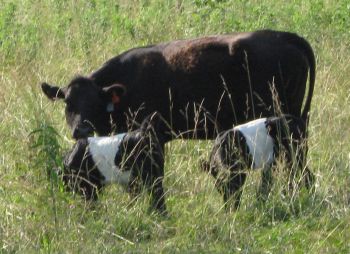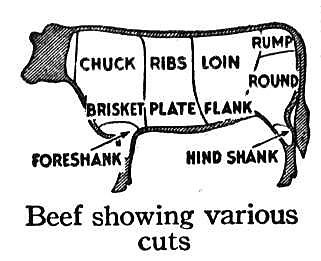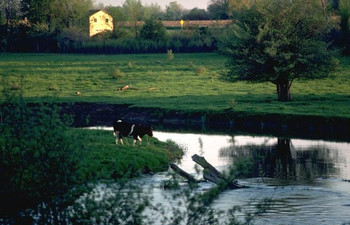Grass Fed Beef is: Safer, Healthier, Cheaper, Greener
 The reasons we raise grass fed beef are few. And they boil down to simply these four.
The reasons we raise grass fed beef are few. And they boil down to simply these four.
It's our opinion - based on our experience - that Missouri grass fed beef is the best solution for all of these points.
1. Safer
In any supermarket, you can't tell that two steaks laying next to each
other actually came from the same beef carcass. Unless you see that
carcass actually cut into its pieces, you won't know what animal it came
from. But even then, you won't know how that cow was raised or what it
was fed. And you don't know how it was processed into that meat you are
buying.
This is exactly how all these infectious diseases get circulated.
People trust that corporations, inspected by governments, actually know
and do best for everyone. Neither corporations or governments do their
jobs perfectly. Some short-cuts get taken here and there. They aren't
caught and traced until someone gets sick.
And that system works only as long as everyone follows the rules. But it's not a perfect system.
Last time I followed the government tracing down a contagion which
escaped, it traced to hamburger which was mixed together from 4 states
and 3 countries. Somewhere, along the line, a processor goofed, short
cut, cheated. And the result was that an untraceable infection was let
loose into hamburger and widely distributed.
The result was that a few people died, a lot of people got sick. One
person wound up paralyzed for life. Her mother cooked her up a hamburger
from meat bought at the same local supermarket in their neighborhood.
With locally-raised Missouri grassfed beef, purchased from a farmer
you know, processed at a local abbatoir that you can visit - then and
only then will you know that your beef is safe to eat. Only then.
 2. Healthier
2. Healthier
When cows are fed anything but grass, they change. Diet determines the
quality of the animal as it grows. What they are fed influences the
muscle fibers. When they are fed corn grain, then extra fat is added to
their system. Grain doesn't digest well, so the acid-indigestion is
offset with other food additives. This is a solution that becomes
another problem. Often this is where anti-biotics come in.
The overall situation is that the more they "add" to a cow's diet in
order to make the production smoother, cheaper, or faster - those
additives have an effect on the meat. Many of them stay in the fatty,
intramuscular tissues. So what they feed cattle is what you eat, after a
fashion.
That said, cows can and do eat a wide variety of forages in their
natural state. They have four stomachs, which allows them to thoroughly
digest growing material in order to extract all the nourishment they
need. This one biological fact also allows them to digest all sorts of
non-natural diet materials and not only survive, but continue to gain
weight.
When you eat meat harvested from Missouri grass-fed animals, eating
only natural forages, you get the benefit of lean and natural beef. It
is said that where a person could make their diet only on this, they
would actually get all the necessary proteins, minerals, and vitamins
they need. Some have, in fact. While we suggest that you continue
salads, breads, fruits, and milk products (avoids boring "same-old's"
situations), one should take that into account.
A healthy diet would start with healthy foods, though. And grass fed
beef is healthier than many, if not all feedlot-produced meats.
 3. Less Expensive
3. Less Expensive
Buying a Missouri beef by the quarter takes out tons of middlemen -
literally. A beef raised by a farmer, and sent to a processor, then
delivered to you, has no real middlemen. You pay the processing fee and
the farmer's growing costs.
What you don't pay is having it trucked all across the country to go to
different specialty plants which kill, part, and wrap the meat. Then it
winds up in a supermarket. That's at least two more layers of workers
which have to be paid, along with all those trucks, plants, warehouses,
and stores.
Now some object to the cost of hamburger when you buy it direct from
the farmer. But they often don't see that the various steaks, roasts,
and other cuts are also the exact same price. Supermarkets charge much
more for choice cuts. If you actually price the separate cuts by name,
you'll find that a quarter-beef costs you 3/4's less than the same
pounds of cuts bought separately.
The bargains are in buying direct and buying in bulk. Value you can't arrange from your local big-box supermarket.
 4. Greener
4. Greener
While it's quite a buzz-word, growing "green" products is hard for many
industries. There are all sorts of arguments about whether feed-lot
beef or pasture-finished beef are more environmentally "friendly".
For us, the argument was solved when we found out that it was less
expensive and just as productive to raise cattle using all-natural
methods. Our cattle eat natural forages all their lives. If they need
medicine to cure an illness, the vet gives it to them. But because they
live healthier lives in natural surroundings, our vet bills have become
less and less. Not all that surprising.
When our cattle eat corn, it's the whole plant when it's growing and
green. (Did you know that corn is a grass?) But they mostly eat a huge
variety of grasses and forbs and clovers, plus others. (For instance,
they like to eat tree leaves, as it is a natural wormer.)
By keeping cows on pasture 24/7/365, you actually take nearly nothing
away when you process that animal into meat. Well over 90% of what the
cow eats returns right into the soil, in a manner which helps that soil
raise even more grass than before. Feedlots have trouble with the
manure. Our Missouri cattle put that manure right back where it would do
the most good. It's natural fertilizer, after all. And so our pastures
are constantly improving. We don't have to spray them or fertilize them -
ever.
So any argument that we have to use carbon-based fuel for anything
other than moving that cow to the processor is moot. Our cattle are born
here, raised here, and the lucky few old cows are buried here.
Everything else - you get. Meanwhile, they consume no fossil fuels, but
help the land sequester more "greenhouse gases" than they create with
their digestion. Tell me a feedlot can make those claims.
Summary
When you next have a chance to go to a commodity or big-box
supermarket. Ask the manager or stock-person where that meat came from -
and if those two steaks sitting side by side actually came from the
same animal. And who processes that cow into meat. You'll find they
don't actually know.
But now you know that your best pocketbook/wallet value, your best red
meat raised in the "greenest" fashion, and perhaps the healthiest
protein is also the safest. If you know your farmer, know your
processor, and buy Missouri grass fed beef by the quarter.
And if you want to see how the safest, healthiest, cheapest, and
greenest Missouri grassfed beef is raised - just come visit our farm.
We'll answer all your questions and show you around. And you can reserve
your next order at the same time.








No comments:
Post a Comment